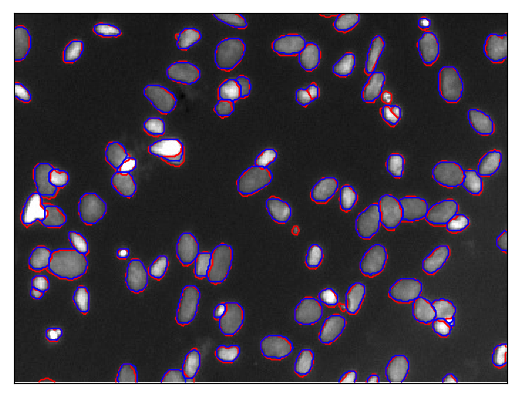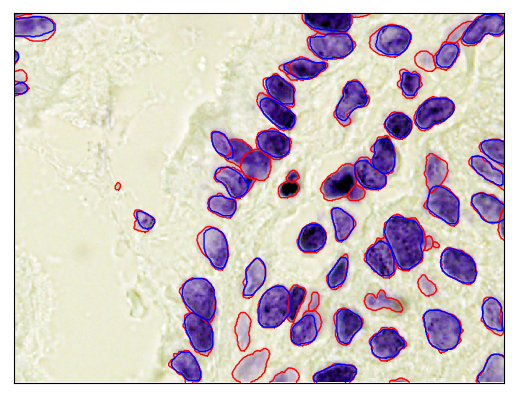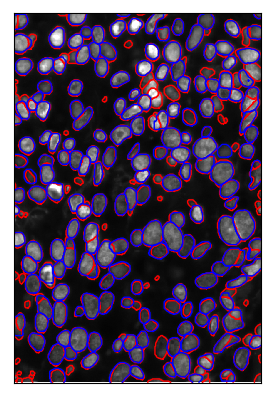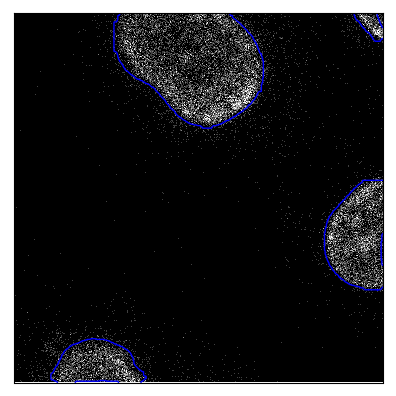mirzaevinom / Data_science_bowl_2018
Programming Languages
Projects that are alternatives of or similar to Data science bowl 2018
The 2018 Data Science Bowl: "Spot Nuclei. Speed Cures."
This repository contains scripts of my solution to The 2018 Data Science Bowl. Goal of the competition was to create an algorithm to automate nucleus detection from biomedical images.
Weights are now available here.
Model overview
For this competition, I modified Matterport's implementation of Mask-RCNN deep neural network for object instance segmentation. I adapted the existing model configurations to detect small nuclei in images with varying size and modality. To ensure that the model doesn't overfit, I used an external dataset and relied heavily on image augmentation. Moreover, generated mosaics from train images based on this notebook. To improve generalizability of the model, I split (using stratification) the stage1_train dataset into train and validation sets based on 5 image modalities provided by Allen Goodman. After training the model using Resnet101 as a backbone encoder and Adam as an optimizer, I improved prediction accuracy by test time augmentation and post-processing the masks.
Training Method(s)
Pre-processing
- I noticed some issues with the provided masks. Therefore, used the annotations and mask provided by Konstantin Lopuhin in data quality issues thread.
- Removed the alpha channel from the images.
- Filled holes in the masks
- Split (using stratification) the
stage1_traindataset into 90% train and 10% validation sets based on 5 image modalities provided by Allen Goodman. - Used an external dataset provided in the forum. Divided the images and the masks into 4 pieces due their large sizes. External dataset download links.
- Generated mosaics from train images based on Emil's notebook.
Model and Training
-
Modified Matterport's implementation of Mask-RCNN deep neural network for object instance segmentation.
-
Tuned hyperparameters to detect small nuclei from the images. (I found this tutorial very useful for understanding the model hyperparameters)
- Original Matterport implementation was validating only on one image so fixed this validation issue.
- Reduced RPN (region proposal network) anchor sizes since the nuclei are mostly small.
- Increased number of anchors to be used since the nuclei are small and can be found anywhere on an image.
- Increased maximum number of predicted objects since an image can contain 300 or more nuclei.
- Increased
POST_NMS_ROIS_TRAININGto get more region proposals during training. - Added extra parameter
DETECTION_MASK_THRESHOLDto model configuration. Default was hardcoded in the model as 0.5 but setting it to 0.35 helped in detection of small nuclei boundaries. - Resized images and masks to 512x512
-
Relied heavily on image augmentation due to small training set:
- Random horizontal or vertical flips
- Random 90 or -90 degrees rotation
- Random rotations in the range of (-15, 15) degrees
- Random cropping of bigger images and masks to 256x256x3.
- Random scaling of image and mask scaling in the range (0.5, 2.0)
-
Used Resnet101 architecture as a backbone encoder but initialized the first 50 layers of the model with pre-trained Resnet50 weights from ImageNet competition.
-
Trained the model with Adam optimizer for 75 epochs:
- 25 epochs with learning rate 1e-4
- 25 epochs with learning rate 1e-5
- 25 epochs with learning rate 1e-6
-
Did not retrain the model with stage1 test data during stage 2 as I was afraid of overfitting on black and white images.
Post-processing
- Combined predictions on actual image and horizontally flipped image: took unions of masks with maximum overlap and removed false positive masks with small overlap.
- Due to configured RPN anchor sizes, the model predicts small nuclei very well. However, it struggles at predicting large nuclei. Therefore, if a model predicts no masks for an image then I scale down the image and predict once again.
- Removed overlaps between predicted nuclei based on their objectness score. In other words, removed intersections from the masks with lower scores.
- If this intersection removal results in multiple objects in that mask, then removing all the small pieces.
- Closing small holes inside the masks using morphological operations (dilation followed by erosion).
Interesting findings
- Mask-RCNN model overfits easily without image augmentation.
- Removing false positive mask predictions improves the overall score significantly.
- Since images are on different scales, predicting masks on scaled images helps with the model generalizability.
- Dilating and then eroding individual masks helped me achieve slightly better result.
- Matterport's original implementation was only validating on only one image. Fixing this issue made the training process reproducible.
- I found that the model reaches a local minima faster when trained using Adam optimizer compared to default SGD optimizer.
Unsuccessful approaches tried
- Trained the model with Dice Coefficient Loss instead of default binary cross-entropy loss for the masks heads. Although got comparable results couldn't beat prediction accuracy of binary cross-entropy on my validation set.
- Trained with random Gaussian and Poisson (or shot) noise for image augmentation. It actually hurt overall model performance.
- Tried ensembling actual image predictions with horizontal and vertical flip predictions. Used non-maximum suppression for removing overlaps. Did not improve prediction accuracy on the validation set.
- Trained end-to-end without initializing with pre-trained ImageNet weights. Mostly got to Mean IoU score of 0.35 on stage1 test set.
- Trained on preprocessed images with adaptive histogram equalization (CLAHE). The model performed way worse.
Example model predictions
For the following figures red lines represent ground truth boundaries and blue lines represent prediction boundaries.
- Model predictions for some stage 1 test image samples:
- Model predictions for some stage 2 test image samples:
Appendix
A1. Model Execution Time
The following execution times are measured on Nvidia P100 GPUs provided by Ohio Supercomputer Center
- Each training epoch takes about 12 minutes.
- It takes about 15 hours to train the model from scratch.
- It takes 1 to 4 seconds to predict all the nuclei on a single image.
- Plotting boundaries of each nuclei and saving plots adds an extra 1 second on average
A2. Dependencies
The codes are written in Python (3.6.3) and tested on Red Hat Enterprise Linux Server (7.4). The scripts depend on the following python libraries available on PyPi:
-
tensorflow (1.3.0), keras (2.1.3), numpy (1.13.3), scipy (0.19.1)for computations -
cv2 (3.4.0), skimage (0.13.0), matplotlib (2.1.0)for image processing and plotting -
tqdm (4.11.2)for progress bar
A3. How To Generate the Solution
- Download/extract/place the training (external dataset download links ) datasets in the following folder structure:
project
|-- codes
|-- data
|--- stage1_train
|-- imageID
|-- images
|--- masks
|-- stage1_test
|-- similar to stage1_train
|-- stage2_test
|-- similar to stage1_train
|-- external_data
|-- tissue_images
|-- imageID.tif
|-- annotations
|-- imageID.xml
-
Run
python augment_preprocess.pyto pre-process external data and create mosaics from the dataset. (You can skip this step if you only want to train on provided train set) -
Run
python train.pyto train the model. Model weights are saved at../data/logs/kaggle_bowl/mask_rcnn.h5. -
Run
python predict.pyto evaluate model performance on validation set and predict nuclei boundaries on test set.
Acknowledgements
- This material is based upon work supported by the National Science Foundation under Agreement No. 0931642 (The Ohio Supercomputer Center)
- I would like to also thank Mathematical Biosciences Institue (MBI) at Ohio State University, for partially supporting this research. MBI receives its funding through the National Science Foundation grant DMS 1440386






